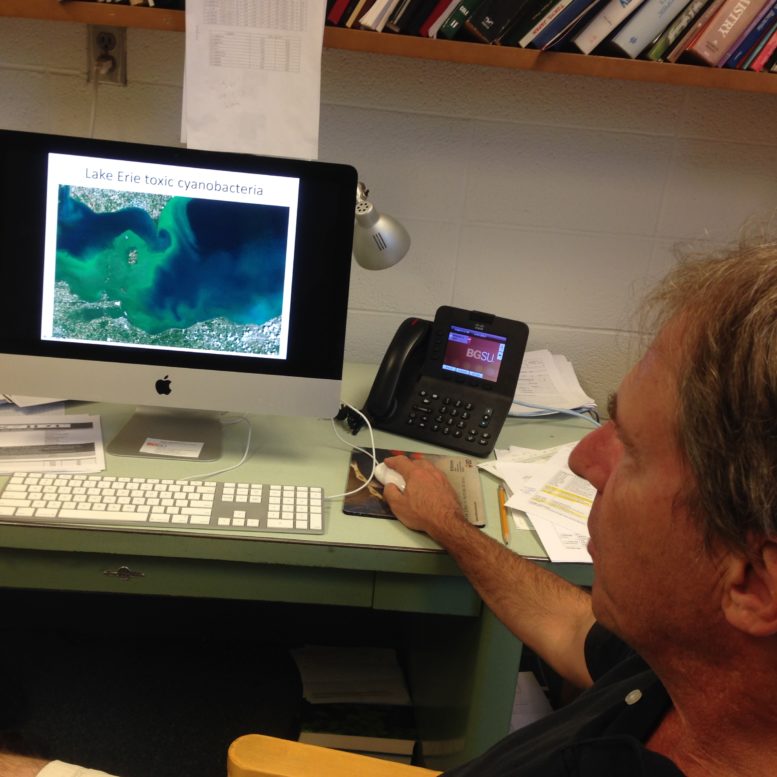By BGSU OFFICE OF MARKETING & COMMUNICATIONS
In August 2014, toxins from algal blooms in Lake Erie shut down the city of Toledo, Ohio’s water supply, leaving half a million residents without potable water for more than two days. A new study co-authored by Bowling Green State University researchers shows that a virus may have been involved in the crisis and suggests methods for more stringent monitoring of water supplies.
Michael McKay, Ryan Professor of Biology, and George Bullerjahn, Professor of Research Excellence, both at BGSU, worked with a team of 25 researchers to examine the physiological traits of Microcystis, the cyanobacterial organism responsible for scum-like algal blooms in Lake Erie. They found that it was consistent with algal blooms from 2012 and 2013 except for one thing – the Microcystis cells had a viral infection. Typically, toxins from algal blooms are trapped within the cell until the cell dies. But virus infections can cause cells to break open, leaking the toxin into the water and subsequently into water facility intake pipes and treatment centers.
The viruses analyzed in this study infect only bacteria and do not infect humans.
“The study changes the way we think about how the toxin moves around aquatic systems and gets into water supplies,” said Steven Wilhelm, Mossman Professor of Microbiology at the University of Tennessee, Knoxville, who led the study. “It may help us understand how these organisms persist in nature.”
The study was published recently in the journal Environmental Science and Technology.
Co-authors included Wilhelm and his team from the University of Tennessee; Tim Davis of the National Oceanic and Atmospheric Administration Great Lakes Environmental Research Laboratory; and Gregory Dick of the University of Michigan.
The scientists documented the viral infection by sequencing RNA from the Toledo water samples. They also used computer mathematical models to simulate how the algal blooms moved through water: satellite images were used to pinpoint where the blooms were on certain days and computer models filled gaps in between.
McKay recalls coordinating with NOAA’s Davis and UT’s Wilhelm to obtain samples for RNA sequencing within hours of the “Do not drink” advisory being announced on Saturday, Aug. 2, 2014. “Recognizing that this group of scientists had the knowledge and tools to get to the bottom of this, Steve [Wilhelm] was pressing us to get samples while the bloom was still encroaching on the water intake” McKay said.
“The biggest thing we’re learning is that there are dissolved and particulate sources of the toxin,” Wilhelm said. “We historically think of toxin as being stuck in the cell. In this study, we have identified a way for the toxin to move from particulate to the dissolved phase.”
“Particulate” is a term used to describe anything bigger than a cell, something that is commonly collected on a filter. It is “dissolved” once it is able to slip through the filter.
The finding justifies the need for scientists and municipalities to monitor the toxin differently than they have traditionally done—looking at the dissolved or cell-free phase rather than just the particulate stage, Wilhelm said. This would allow water management authorities to better detect the toxin before it spreads through the water supply.
“There are ways to do the dissolved phase, but they are cumbersome and not typically run by most monitoring agencies,” he said. “This study stresses the need to do that.”
Next steps include examining whether the viral infections play a role in controlling the population of toxic algae and continued studies on the nutrients these cells use to grow. The scientists already have made a novel observation in this study, confirming cells were using urea as a nitrogen source.
“It’s making us re-evaluate how nutrients may shape the microbial communities,” Wilhelm said.
Researchers are still trying to understand why algal blooms have exploded in growth since the 1990s in bodies of water around the country and the world.
While the BGSU team had been studying algal blooms in Lake Erie prior to the Toledo Water Crisis, “This event was a game-changer,” noted McKay. “Since the water crisis, we have become more involved in helping to shape policy through our interactions with Congressman Bob Latta’s office and through our scientific contributions and outreach efforts, BGSU is being recognized as a leader in freshwater harmful algal bloom research.”
“Algal blooms are growing in intensity, severity and frequency and we’re trying to understand why,” Wilhelm said. “This study is another piece of the puzzle.”

